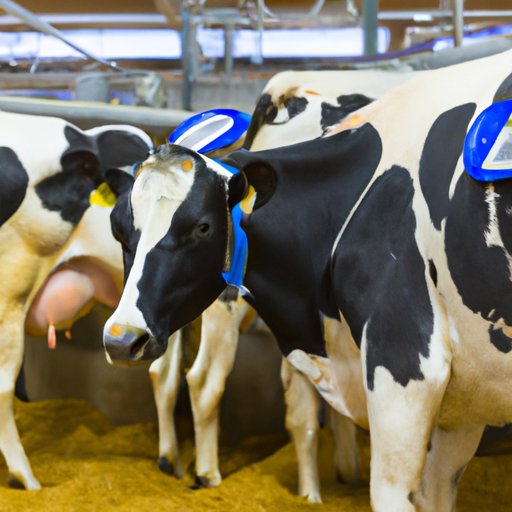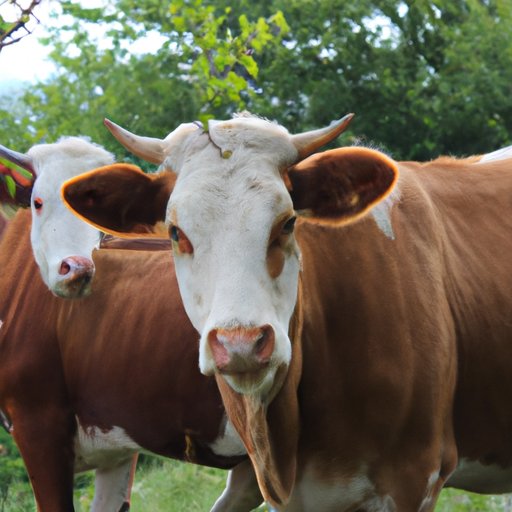
Introduction
Mad Cow Disease, also known as bovine spongiform encephalopathy (BSE), is a neurological disorder that affects cows. This disease has caused widespread concern and panic in the agriculture industry and beyond, due to the human variant of the illness known as variant Creutzfeldt-Jakob disease (vCJD) that can result from consuming contaminated meat products. It is important to understand the causes of Mad Cow Disease and its transmission in order to prevent future outbreaks.
The Science behind Mad Cow Disease: Exploring Its Origins and Causes
Mad Cow Disease was first identified in the United Kingdom in the 1980s, where it affected thousands of cattle and led to the culling of millions more. The disease was named “mad cow” due to the behavioral symptoms seen in infected cows such as aggressiveness and abnormal posture.
The causative agent of Mad Cow Disease is a type of protein called prions. Prions are unique in that they do not contain genetic material like viruses or bacteria, and are simply abnormal forms of a normal cellular protein. When prions come into contact with normal prion proteins, they can cause them to take on the abnormal shape, leading to the formation of clumps and plaques in the brain that interfere with normal functioning and eventually lead to death.
Understanding Mad Cow Disease: A Comprehensive Guide to Its Causes
Mad Cow Disease can be transmitted through contaminated food, such as meat from infected cattle that enters the human food chain. Symptoms of the disease can take years to show up, and can include changes in behavior, coordination, and muscle control. There is no treatment for Mad Cow Disease, and infected animals must be culled to prevent the spread of the disease.
Diagnosis of Mad Cow Disease involves examining the brain tissue of infected animals for the presence of the abnormal prion proteins. Prevention of the disease involves strict regulations on feed and hygiene practices in the agriculture industry, as well as careful monitoring of the food supply and early detection of infected animals.
Mad Cow Disease: What Causes It and How to Prevent the Spread
Mad Cow Disease can spread through the consumption of contaminated meat products, as well as through the use of contaminated feed for cattle. The primary cause of Mad Cow Disease is thought to be the feeding of infected cattle parts back to other cattle in the form of animal feed. This practice has since been banned in many countries to prevent the spread of the disease.
To prevent the spread of Mad Cow Disease, it is important to properly dispose of infected cattle, quarantine infected herds, and regulate the production and distribution of animal feed. Any meat products suspected of contamination should be immediately recalled and destroyed to prevent human exposure.

The Connection between Cows and Humans: Unraveling the Causes of Mad Cow Disease
While Mad Cow Disease primarily affects cows, humans can be affected by a variant of the disease known as vCJD. This variant is thought to be caused by consumption of contaminated meat from infected cattle.
The connection between cows and humans has been traced back to the farming practices of the agriculture industry. The use of animal parts in feed, as well as the overcrowding and unsanitary conditions of many feedlots, have contributed to the spread of Mad Cow Disease and other diseases among cattle.
It is important for the agriculture industry to prioritize the health and safety of both animals and humans by implementing stricter regulations and hygiene practices to prevent the spread of disease.
The Role of Food Safety in Preventing Mad Cow Disease Outbreaks
Food safety is crucial in preventing the spread of Mad Cow Disease and other illnesses associated with the food industry. Regulations surrounding animal feed production, slaughterhouse practices, and food processing must be enforced to ensure the safety of both animals and humans.
Controlling disease in the food system involves monitoring the entire supply chain, from feedlot to grocery store, and implementing strict regulations on the production, transportation, and sale of food products. This includes testing for the presence of abnormal prion proteins, as well as ensuring proper sanitation and hygiene practices in all stages of the food production process.
The Evolution of Mad Cow Disease: Exploring Possible Causes and Future Implications
Mad Cow Disease has evolved over time due to changes in the agriculture industry and the spread of the disease to other countries. The implications of these changes have yet to be fully understood, but continued research is necessary to prevent future outbreaks and protect both animals and humans from the effects of the disease.
Future directions for research and prevention involve developing new testing procedures and identifying new methods for controlling the spread of the disease. Despite progress made in controlling the disease in recent years, there is still a need for increased awareness and continued efforts towards preventing the spread of Mad Cow Disease.
A Deep Dive into the Causes of Mad Cow Disease: From Prions to Contamination
Prions are the primary cause of Mad Cow Disease, as they can be transmitted through contaminated animal feed and other sources of contamination. Improper disposal of infected animal parts, as well as the use of animal parts in feed, has contributed to the spread of the disease within the agriculture industry.
Other possible causes of Mad Cow Disease include genetic factors and exposure to environmental toxins. However, prions remain the most well-documented cause of the disease and continue to be a major concern for the agriculture industry and public health officials.
Conclusion
Mad Cow Disease is a complex and challenging disease that requires continued research and prevention efforts to control its spread and protect both animals and humans. Understanding the causes of the disease is crucial in preventing future outbreaks and developing effective prevention and treatment strategies. By prioritizing food safety and implementing strict regulations and hygiene practices, the agriculture industry and public health officials can work together to control the spread of Mad Cow Disease and other illnesses associated with the food system.





